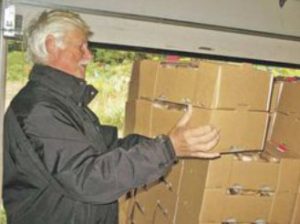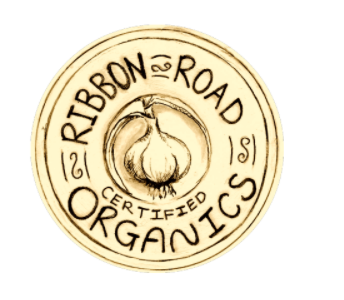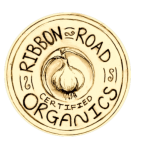This piece written by Scott Shelters from the Post Journal is one from the archives that tells our story in a beautiful way!

The mere mention of garlic throughout October would make many think of the various Halloween-related myths surrounding the vegetable.
That’s not the case for the employees of Ribbon Road Farm in Sherman. Owners Alan and Kathleen Ramm may spend a little more time with garlic than most area citizens. However, their garlicgrowing operation has nothing to do with vampires or werewolves. For the Ramms, garlic growing began as a simple part of a busy life 10 years ago, when they moved to Lyons Road after living in South Africa for 14 years.
“I’m really a chemical engineer and a consultant to a lot of companies,” said Ramm. “This garlic and herb thing was just kind of a fun hobby.”
He didn’t think anything more than that of garlic when he and his wife first returned to the United States, moving into the house once owned by his grandparents. “I bought 5 pounds of elephant garlic and 5 pounds of reddish garlic from a guy in Westfield, who had been growing garlic for many years,” he said. “We planted it, and it did really well.” At that point, the Ramms’ hobby spun out of control. “We started expanding it,” he said. “Friends would come and say, ‘Can we have some garlic?’ We’d give it to them. They started to have their friends come, so we said, ‘Well, we’ll sell garlic to you,’ so we started selling it. We just had more and more of a demand,” Ramm said. “As hobbies go, you can sometimes get in over your head. It just kept getting bigger.”
Today, the Ramms handle just a bit more than the 10 pounds of garlic they purchased 10 years ago. “This year, we probably harvested at least 12,000 pounds of garlic,” he said. The growth in garlic production has led to job options for area residents.
“As we grow, it’s an opportunity for people in the area to gain employment,” Ramm said. “It’s a great job for kids in the area on summer vacation if they don’t mind working too hard. We have some kids who just love it.” At any given time, somewhere between four and 12 area residents will be employed at Ribbon Road Farm. “We pay well, so the kids don’t feel like they’re getting ripped off,” added Mrs. Ramm. “We do better than McDonalds, they say. It benefits them and it benefits us. We try to keep a community type of feeling all the time.”
That growth in production has also led to an increase in visibility for the Ribbon Road Farm products, which can be purchased at the farm
and in Wegmans, Tops and many other locations throughout New York and Pennsylvania. Named for the ribbon-like shape of Lyons
Road, Ribbon Road Farm produces garlic that can be found in about 70 Wegmans locations.”
I think the real breakthrough was when Wegmans decided they could trust us to actually deliver a reasonable quantity of this garlic to them,” Ramm said. “They were looking for certified organic elephant garlic, so we started in with them about four years ago now. We’re just about ready to ship 6,000 pounds to Wegmans. It goes to Rochester and then it gets distributed to the different stores.”
HOW DO THEY DO IT?
The production of 12,000 pounds of garlic cannot be done overnight. The Ramms and their employees go through an intense planting process each fall and an equally involved garlic-harvesting project each spring. “All of the garlics are raised pretty much the same,” said Ramm. “You take a garlic bulb and you break it up into the cloves. You take a clove, and you plant it in the ground right around this time of year. In our climate, you want to plant it this time of year, and you want to cover it with about 2 inches of dirt, so it’s really in the ground.” Garlic growers know they can’t just mindlessly toss bulbs into the ground, however. They must pay attention to the clove’s positioning throughout the planting process, making sure they plant each clove with its root side farthest into the ground and the pointed side closest to the surface. If the cloves are planted improperly, the garlic roots will be forced to grow up and around the clove to reach the surface, wasting energy.
Due to the importance in each clove’s positioning, Mrs. Ramm noted the involvement of the human element. “It’s the most labor intensive of all produce,” she said. “A machine can’t distinguish between up and down.” “There’s more human interventions in handling and getting the garlic than any other vegetable. It’s hand planting right from the beginning,” added Ramm. “We use a machine to punch holes in the ground, but we hand plant each of these cloves.”
The harvesting process can be equally involved. “The roots on this garlic will get to be a couple of feet long, so that becomes the challenge when you want to dig it up around the Fourth of July,” Ramm said. “Particularly in heavier soils like we have in Chautauqua County that are high in organic material, you’re not going to be able to pull it out of the ground. What you’ll do is break the top off.” An error during the harvest can cause seriously problems for a garlic bulb. “If you break the top off when it’s green, you run the risk of getting infection from fungus and bacteria into the bulb, and then your bulbs will rot. You have to dig it.”
Since they began the garlic operation on Ribbon Road Farm, the digging process has evolved. “The way we started was just the way most people have a garden with garlic do. You take a fork, like a manure fork, you go out and you stick it in and loosen the soil up to get out your garlic,” he said. “Now, you take a field like we have, which probably has close to 80,000 plants for next year, there’s no way you’re going to take a manure fork around. We use a specially designed cutter that goes underneath the bed and just chops the roots off. That way you can just lift it out.”
From there, the Ramm’s employees come back into play. “The bar goes through the field and it throws these up,” said Mrs. Ramm. “(The employees) go through and make bundles of it. Other people come along, and they take the bundles and load them in the cart and take them to the barn, and then they’re hung.” The bulbs then hang from the ceiling of the Ramm’s barn for about six weeks. “You’ve got the hand labor of planting, the hand labor of bundling, the hand labor of hanging and the hand labor of taking them down.”
As the operation grows, the Ramm’s barn experiences an overpopulation of garlic.
“The downstairs of the barn was literally a sea of garlic,” Ramm said. “When it comes down, it is not pretty. Garlic has these little bulb wrappers on it. They’re muddy, dirty and really ugly looking.” Consumers and store owners are not interested in purchasing dirty bulbs. As a result, the garlic requires additional human intervention before it makes it way to store shelves.
“What you have to do is cut off the stems, cut off the roots and clean off the outside by knocking off two or three of these bulb wrappers,” he said. “That way you have a clove of garlic that looks presentable and nice, which is what you see in the store. That’s all done by hand.”
Of course, the bulbs don’t just package themselves. That means even more work for the Ramms and their employees. “Then it’s sized and graded and some of it’s broken up for planting for next year. The different varieties are all packaged depending on the purchases of the people that are interested in them,” Mrs. Ramm said.
This year, Ribbon Road Farm garlic found at Wegmans features a new kind of plastic packaging, replacing the netting that is still used at Tops locations. “This packaging is a new idea this year,” Ramm said. “This netting is kind of the traditional way to package elephant garlic, because it falls apart. Since the cloves fall apart, we decided to go with not just this approach. We call (the newly packaged garlic) our Chef Ready variety. It ends up being a lot more convenient for the average person to use. You don’t have to break the bulb up. You just pull a clove out.”
Each new package contains approximately 6 ounces of garlic. The new packaging has inspired Ramm to think of another innovative garlic-related idea. “This year, we’re really seriously thinking about producing little gift baskets with a variety of four or five different types of garlic and recipes,” he said.
THE SPECIFICS
“Most of what we harvest is elephant garlic,” Ramm said, holding up a softball-sized bulb. “This is the granddaddy of them all.” “You could kill somebody with that,” added Mrs. Ramm. The Ramms’ produce about 11,000 pounds of elephant garlic each year. Additionally, they harvest 1,000 pounds of hardneck and softneck varieties.
“Elephant is the biggest garlic. It forms the biggest bulbs. It’s the milder garlic, but it’s the king of roasting garlic,” Ramm said. “Americans are slowly becoming educated on the different types of garlic and their advantages in flavor and cooking,” Mrs. Ramm added. “Some are really great for Mexican foods. Some are really great for Italian, depending on the heat or the depth of flavor that you want. It’s sort of an interesting place to be, when we ourselves are trying to expand the variety, to educate people on the different types. The average person thinks that garlic is garlic.”
The average person can purchase garlic right on Ribbon Road Farm at 8438 Lyons Road, Sherman. The owners ask customers to call first at 326-6150. Of course, area residents may also purchase the produce at Wegmans or Tops locations. Buyers of Ribbon Road Farm garlic will cut into organically grown bulbs.
“I believe in the organic certification,” Ramm said. “It’s like having a doctor that either has a certificate that says he actually went to medical school or a doctor that says, ‘Well, I did everything that you do in medical school. I just don’t have the certificate.” With a rapidly growing, organic operation, Mrs. Ramm has noticed a growth in the quality of garlic her farm has produced over the years.
“Our garlic is starting to get really happy where it is,” she said. Each fall, the Ramms put some of their harvested bulbs back into the ground, making each summer’s harvest a little better than that of previous years. “We just replant the garlic that we grow,” Ramm said. “That’s how we got from 5 pounds to 12,000 pounds. It’s a hobby that’s out of control.”

